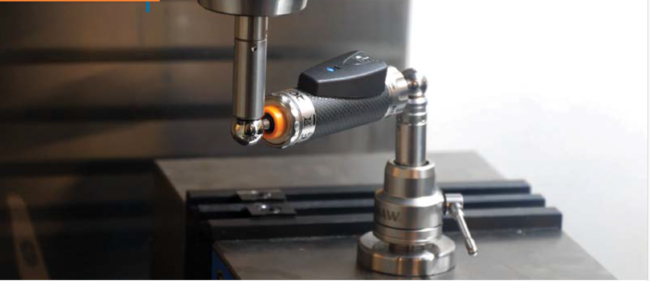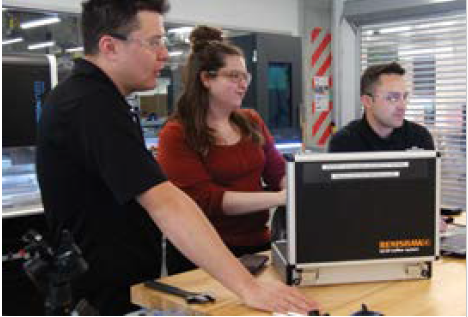
Global engineering technologies company Renishaw has collaborated with Autodesk, a leader in design and make software, to enhance machine calibration at two Autodesk Technology Centres in North America. Autodesk’s teams in San Francisco and Toronto successfully calibrated equipment using Renishaw’s QC20 ballbar, ensuring their machines are performing within specification.
Autodesk operates four Technology Centres across North America and Europe for research and development and workflow validation, with knowledge and equipment shared between facilities. Each Technology Centre has specific focus areas, including architecture, engineering, construction and operations, advanced manufacturing, and robotics.
“Our Technology Centres are staffed by expert researchers and design engineers who work with highly sophisticated equipment to validate digital workflows,” said Mary Elizabeth Yarbrough, Manager, Autodesk Technology Centre, San Francisco. “Our work helps us to understand how our software is used, as well as push the boundaries of what is possible by developing and validating workflows.”
To deepen its understanding of calibration and metrology, Autodesk invited Renishaw to its Technology Centre in San Francisco to conduct advanced ballbar testing and deliver metrology training for its North American team.
During the four-day training course, Renishaw’s team shared expertise in precision measurement, covering set-up, foundational metrology, gauge repeatability and reproducibility, geometric dimensioning and tolerancing, and system integration. The training also involved hands-on calibration using the Renishaw XM-60 multi-axis calibrator and QC20 ballbar, conducted on three machines—Mazak, Haas, and Matsuura. One of the machines was found to be out of calibration.
Misalignment Correction
Machine tools can become misaligned during transport or operation due to environmental impacts and normal wear and tear. At the Autodesk Technology Centre in San Francisco, which specializes in prototyping — often producing one-off parts with wide tolerances — it is not always immediately obvious if a machine is out of calibration.
“Due to the earthquake risk in San Francisco, all our machines are seismically anchored,” explained Orion Beach, Senior Research and Design Engineer, Autodesk Technology Centre, San Francisco. “This process can cause misalignment in the machine tools — changes to the bottom of the machine can have a knock-on effect on overall performance.”
Brian Jeong, Senior Research and Design Engineer, Autodesk Technology Centre, Toronto, went on to describe the challenge of calibrating machines in Toronto: “As the facility is on the third floor, manufacturing equipment is brought up in a size and weight restricted elevator. As a result, machine tools are often disassembled to be brought upstairs and reassembled in the workshop, where they require calibration.”
Applying QC20 Ballbar
Autodesk invited Renishaw to use the QC20 ballbar to check the accuracy of the machines at the Technology Centre in San Francisco. Ballbar testing is a quick way of checking a CNC machine tool’s positioning performance, helping to benchmark and track its condition. The data collected is used to calculate overall measures of positioning accuracy (circularity, circular deviation) in accordance with international machine performance standards (ISO 230-4 and ANSI/ASME B5.54).
“The QC20 ballbar is a telescoping linear sensor equipped with precision balls at both ends,” explained Denis Vasilescu, Industrial Metrology at Renishaw. “In use, the balls are kinematically located between precision magnetic cups, one attached to the machine table and the other to the machine spindle or spindle housing. The QC20 ballbar follows a programmed circular path to measure minute variations in radius. The QC20 ballbar has a reputation for being a quick and effective way to verify machine tool performance. This helps operators to diagnose the source of errors and take preventative steps to resolve issues early.”

Eye-Opening Results
Using the QC20 ballbar and its intuitive software workflow, the team in San Francisco can now check a machine’s calibration in under 10 minutes, without needing to call out a technician.
Following this success, Autodesk invited Renishaw to its Technology Centre in Toronto to inspect a newly installed CNC machine for maintenance and alignment, again using ballbar testing.
Jamie Nicholson, Research and Design Engineer at Autodesk Technology Centre, Toronto, highlighted the accuracy of the QC20 ballbar, stating, “Following the QC20 ballbar testing and recalibration, the CNC machine is cutting parts beautifully. It has increased our confidence in the accuracy of our machine tools. Autodesk can now conduct regular ballbar testing to ensure accurate parts from CNC machines, reducing machine downtime, scrap, and inspection costs.”
Now that the Technology Centres in San Francisco and Toronto are satisfied with the results of the project, the next stage is to send the QC20 ballbar to the Technology Centre in Boston. In the future, the team plans to share the equipment across the North American facilities to incorporate ballbar testing into quarterly and annual maintenance activities, as well as during machine commissioning.
“In this project, Renishaw was instrumental in calibrating our machines. We have built a strong relationship with Renishaw over the years and have a deep trust in its products, services and expertise, which are truly world class.”, says Adam Allard, Senior Manager, Autodesk Technology Centres (North Americas)
“The ballbar testing in San Francisco showed one machine was uncalibrated, highlighting how crucial every step of the anchoring process is. The results were eye-opening and proved the tangible value of implementing metrological safeguards. We used the results to work through the issues and resolve them.”, says Mary Elizabeth Yarbrough, Manager, Autodesk Technology Centres (North Americas).
Article and Images Courtesy: © 2001-2025 Renishaw plc.
This article was published in TAGMA Times




COMMENTS